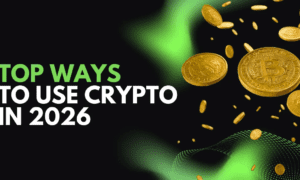The online merchant payment solutions market is undergoing a significant transformation in 2024. A key trend is the integration of cryptocurrency payments into traditional e-commerce systems, driven by growing demand for fast, secure and cost-effective cross-border transactions. Analysts report a 40% increase in cryptocurrency payments within e-commerce over the past year. This surge reflects not only the rising popularity of digital assets but also merchants’ increasing trust in blockchain technologies as a means of optimising financial operations. New platforms combining the advantages of cryptocurrencies with the convenience of traditional payment systems are catalysing these changes. They promise to address long-standing issues in online trade, such as high fees for international transfers and lengthy payment processing times.
For an in-depth analysis of this trend, we spoke with Ivan Grishkov, lead developer at ScionX—an innovative platform offering a fully decentralised, non-custodial ecosystem for cryptocurrency payments. Grishkov, an expert in web development and blockchain technologies with experience in high-load systems and cryptography, has been at the forefront of creating this e-commerce solution. His involvement in the ScionX project brings together technical knowledge and a keen understanding of market needs.
The developer emphasises the relevance of challenges faced by online sellers in the international market. Data supports his observations.
- According to the World Bank’s ‘Remittance Prices Worldwide’ report for the second quarter of 2023, the average global cost of sending remittances stands at 6.4%. For online sellers, this translates to a significant reduction in profits on international transactions;
- McKinsey’s ‘The 2022 Global Payments Report’ revealed that 70% of e-commerce companies consider the complexity of complying with international financial regulations as the primary barrier to global expansion.
The time required for international payments remains an issue.
- SWIFT data shows that in 2023, the average time for an international payment is approximately 1-5 working days, negatively impacting cash flow and customer satisfaction. In light of these challenges, cryptocurrency solutions are gaining particular relevance.
- Deloitte’s ‘2023 Global Blockchain Survey’ indicates that 85% of executives at large companies expect digital assets to be integrated as an alternative or complement to fiat currencies for global payments within the next 3-5 years.
The ScionX platform was created in response to these market challenges. ‘Our goal is to offer a solution that removes the main barriers to international online trade,’ explains Grishkov.
ScionX is an innovative platform for merchants, enabling them to accept payments in cryptocurrencies. At its core, it uses smart contracts to ensure automated and secure transactions from buyer to seller. ‘The key difference between ScionX and traditional payment systems is that we are not a financial intermediary and do not store user funds,’ Ivan emphasises. ‘Our platform acts as a technological bridge, ensuring direct interaction between transaction participants. Moreover, we’ve designed ScionX as an API-ready solution, facilitating easy integration with any merchant platform’.
This approach significantly reduces transaction fees and accelerates the fund transfer process. Moreover, the use of cryptocurrencies addresses the issue of cross-border payments, making the geographical location of transaction participants irrelevant.
ScionX’s unique advantages set it apart from traditional payment solutions. ‘We’ve focused on three key aspects: security, cost-effectiveness, and speed,’ comments Grishkov. Security and transparency of transactions are ensured through the use of smart contracts. This technology guarantees automatic execution of deal terms, minimising fraud risks. ‘Every transaction is recorded on the blockchain, ensuring complete transparency and data immutability,’ Ivan explains.
Cost-effectiveness is achieved by eliminating intermediaries. ‘By removing unnecessary links from the payment chain, we have managed to reduce fees to a minimum,’ notes the developer. According to ScionX data, the average transaction fee is significantly lower than those of traditional payment systems.
Speed and convenience are another key advantage of the platform. Grishkov emphasises: ‘Cryptocurrency transactions are completed within minutes, regardless of the participants’ geographical location”. This is particularly crucial for international trade, where the speed of fund movement directly affects business efficiency. ‘The combination of these factors makes ScionX not just an alternative to existing solutions, but a new standard for payment systems in e-commerce,’ concludes the expert.
The technical aspects of the ScionX product reflect current trends in high-load system development. Ivan reveals the details: ‘We have chosen a technology stack that ensures maximum performance and scalability’.
The platform is built on Ruby on Rails, known for its flexibility and rapid development capabilities. ‘For Docker container deployment, we use Kamal, which allows us to simplify the deployment process and easily scale the system as the load increases.’ — Grishkov explains.
The deployment process is automated using GitHub Actions. ‘We have set up CI configs for continuous integration and delivery, which significantly speeds up the release of updates,’ notes the developer.
In the realm of Web3 technologies, ScionX relies on Blockchain Arbitrum. ‘We have developed our own infrastructure for integration with cryptocurrency wallets and blockchain interaction,’ says Grishkov. ‘Moreover, we have made several improvements to the Ruby gem for blockchain integration, optimizing it for our specific needs’.
On the frontend, the JavaScript framework Stimulus is used in conjunction with Hotwire. ‘This allows us to create a dynamic interface with data updates via web sockets, without page reloads,’ Ivan explains. ‘Stimulus is tightly integrated with the backend, which is crucial not only for performance but also for security, a key principle when working with cryptocurrencies.’
‘Integrating all these components into a unified system is a complex task,’ admits the expert. ‘Though it is precisely this combination of cutting-edge technologies that allows us to provide a unique product in the payment solutions market’.
The innovative approach to security has become one of the key aspects of ScionX’s development. Ivan Grishkov reveals the details of the decisions made: ‘During the design process, we faced a dilemma between user convenience and transaction security’.
Initially, the team considered using native JavaScript methods for blockchain interaction directly in the user’s browser. ‘This solution seemed attractive in terms of simplicity of implementation,’ explains the expert. ‘However, it carried significant security risks’.
The ScionX team decided to move critical operations to the server side. ‘We developed an architecture where sensitive information and key stages of transactions are processed on the backend,’ says Ivan. ‘This required significant system redesign, but the result justified the effort’.
The new approach has significantly improved security levels. ‘Now, users’ confidential data never leaves the protected environment of our servers,’ Grishkov emphasises. ‘This minimises the risks of information interception or compromise’.
Additionally, moving logic to the backend opened up new possibilities for scaling and optimising system performance. ‘We gained greater flexibility in load management and the ability to implement additional layers of protection,’ notes the developer.
In the face of growing competition in the payment systems market, ScionX stands out with its unique approach. Ivan Grishkov draws parallels with well-known industry players: ‘Unlike giants such as PayPal and Stripe, we are not financial intermediaries in the classical sense’.
Traditional payment systems, according to the expert, face a number of limitations related to regulatory requirements and banking infrastructure. ‘PayPal and Stripe are forced to conduct numerous checks, which slows down the process and increases costs,’ he explains.
ScionX, on the other hand, focuses on the use of cryptocurrencies and smart contracts, which allows it to bypass many of these limitations. ‘We offer direct interaction between seller and buyer, without the need for traditional bank accounts,’ notes Grishkov.
Grishkov further expands on ScionX’s unique position in the cryptocurrency payment market. ‘Unlike full-fledged platforms such as BitPay or Coinbase Commerce, ScionX serves as a streamlined payment gateway for cryptocurrencies. This gives us significant advantages in terms of regulatory flexibility,’ Ivan points out. ‘For example, Coinbase Commerce operates only in America and converts cryptocurrency to fiat, thereby facing stricter regulations. ScionX doesn’t perform currency conversion. This means that we can operate globally with fewer regulatory constraints, and the responsibility for crypto compliance falls on the recipient rather than our platform.’
This approach not only simplifies operations but also allows ScionX to offer significantly lower fees compared to competitors like Coinbase Commerce, making it a more attractive option for merchants. However, Grishkov acknowledges potential future challenges: ‘If new regulations are applied to crypto payment gateways, it will present a new hurdle. But for now, our model offers a more accessible and cost-effective solution for global e-commerce.’
This gives ScionX several advantages in the cryptocurrency payment market. ‘Our solution allows easy integration of crypto payments on websites, setting specific payment amounts, and tracking transaction execution through API,’ says the developer. ‘At the same time, we provide a level of automation and convenience comparable to leading traditional platforms’.
Grishkov emphasises: ‘ScionX is not just a payment gateway for cryptocurrencies. We are creating an ecosystem that combines the benefits of decentralised finance with the convenience and functionality of classic payment solutions’.
The development of ScionX became the continuation of Ivan Grishkov’s experience with Web3 technologies. ‘This project opened up new horizons for me in the field of blockchain and decentralised applications, on which I am currently focusing’ he shares.
His background in the field of encryption and security played a special role. ‘My understanding of cryptographic methods proved key to working with blockchain,’ Ivan emphasises. ‘This allowed us to develop a truly secure solution’.
During the project, Grishkov acted as a liaison between various aspects of development. ‘I coordinated the team’s work, combining the efforts of designers, frontend developers, smart contract specialists, and backend developers,’ he recounts. ‘It was a challenge, but this approach allowed us to create a holistic and efficient system’.
Speaking about the development prospects of ScionX and the cryptocurrency payment market as a whole, Ivan Grishkov demonstrates cautious optimism. ‘We are on the threshold of significant changes in the field of online payments,’ he notes. According to the expert’s forecasts, in the coming years we will see an increase in the adoption of cryptocurrencies as a means of payment in the e-commerce sector. ‘Major retailers are already experimenting with crypto payments. This is just the beginning of the trend,’ says Grishkov. However, the developer emphasises that the path to mass adoption will not be easy. ‘Regulatory uncertainty remains a serious obstacle. We are closely monitoring legislative initiatives in different countries and are ready to adapt,’ he explains.
As for ScionX, the lead developer sees growth potential in several directions. ‘We plan to expand the range of supported cryptocurrencies and blockchains. We are also developing tools for deeper integration with existing order management and accounting systems,’ he reveals about the company’s plans. Ivan pays special attention to the issues of system scalability and performance. ‘As the popularity of crypto payments grows, so will the load on platforms. We are already laying the foundation for processing millions of transactions per day,’ the developer emphasises. ‘The future lies in hybrid solutions,’ Ivan is confident. ‘We will witness the gradual merger of traditional financial instruments with Web3 technologies. ScionX is at the forefront of these changes’.
Grishkov notes that the path to widespread adoption of cryptocurrency payments is still ahead. ‘We still have a lot to do in terms of user education and overcoming regulatory barriers. But the potential of this technology is enormous,’ he concludes.
‘ScionX is more than just a business project. It is our impact on the formation of a more open, efficient, and fair financial system of the future,’ Ivan Grishkov concluded, emphasising the global significance of the technologies his team is developing.



































